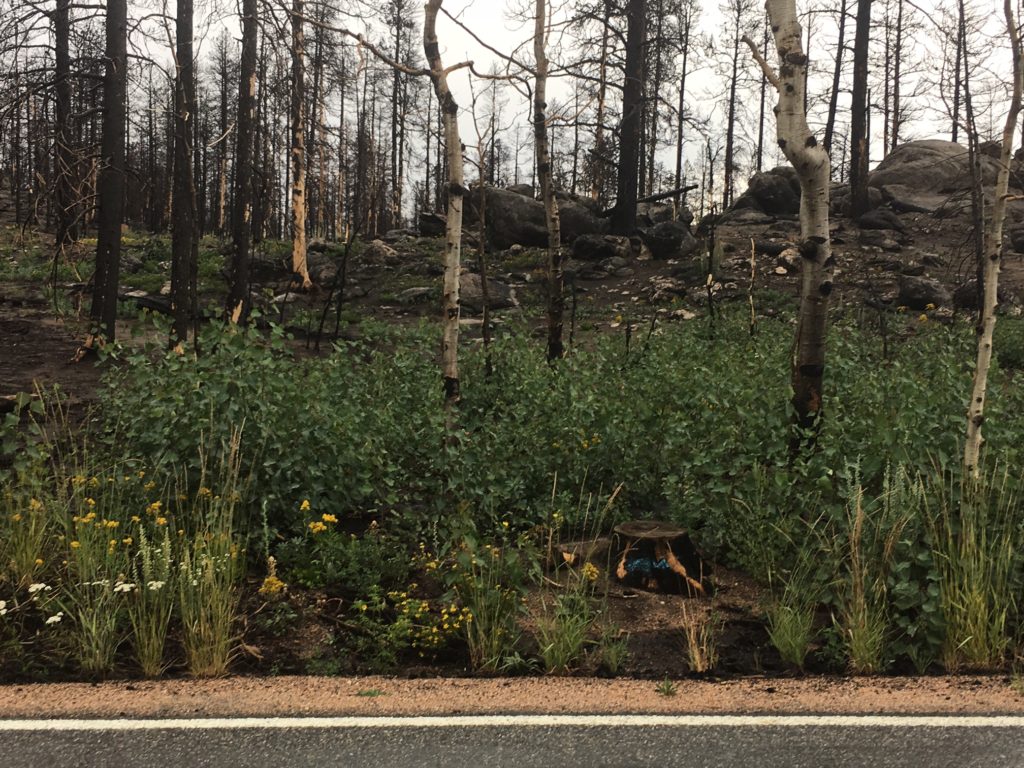
Aspens sprouting in the burn scar
Among the blackened trees, a lot of green is popping up from the ground. Green grass, green wildflowers, and yes, even green trees. Green sprouts right from the base of the blackened trunks, bursting with shimmering leaves.
The bulk of the green are aspen suckers sprouting right from the base of a grove of aspen burned by last summer’s Cold Springs Wildfire. Aspen are one of the most resilient trees growing in the Rocky Mountains. And the last year around Nederland has proven that to be true in many ways.
Just two months ago, we received one of the season’s largest snowstorms, with three feet of snow falling over a 24-hour period. Occurring on May 19, after a run of warm weather, the Aspen had already fully leafed out.
As I walked the road in front of our house, many aspen bowed over the road from the weight of the snow, forming leafy archways. A neighbor who lives in the burn area had just planted new mature aspen around their home, frantically brushed at the snow weighing the aspen down. Part of me felt like I needed to protect them as well, as I grabbed branches and shook the snow off.
Amazingly, though a few aspen did break, most survived this snowfall just fine. One week later, with the snow gone, the Aspen sprung back up to their original form and resumed their spring growth.
Aspen can grow in a variety of life zones and areas of Colorado, from the base of the foothills up into the subalpine just below the tundra. While they love water and do well along streams and rivers, they are hardy enough to grow along ridges and on sunny slopes as well. Where we cut down pines near our home, aspen immediately filled in the gaps, thriving on the sun and lack of competition.
But perhaps nothing tests the hardiness of aspen like a wildfire does. After assessing our property for wildfire mitigation, the one tree we decided to keep closer to our house is Aspen. Aspen simply don’t burn very well, unlike their conifer brethren, that often grow around them.
Crowning wildfires burning through stands of pines and fir that burn into Aspen groves often drop to the ground or even burn around these moist, leafy trees with their thick, white bark. Even when an extremely hot fire manages to burn aspen trees, the result is a rebound of aspen sprouting very quickly.
In the burn scar up the road, the aspen sprouting began with two months of the wildfire. And this summer with the wet spring conditions and some rain recently, the aspen suckers cover the bases of the burnt trees all along Ridge Road.
Some argue that an aspen grove is the world’s largest living thing as an immense grove covering several acres can all sprout from one parent tree, thus sharing the same DNA. This ability to clone makes aspen the first species to grow and dominate in wildfire areas. It also insures the brilliance of color in the autumn that makes this area so breathtaking.
So here’s to the resiliency of aspen, a reminder of nature’s indomitable spirit to persevere, recover and heal from what ever natural disasters come our way.

